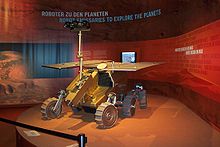


The Aurora programme (sometimes called Aurora Exploration Programme, or simply Exploration Programme) was a human spaceflight programme of the European Space Agency (ESA) established in 2001. The objective was to formulate and then to implement a European long-term plan for exploration of the Solar System using robotic spacecraft and human spaceflight to investigate bodies holding promise for traces of life beyond the Earth.[2][3]
Member states commit to participation in the Aurora programme for five-year periods, after which they can change their level of participation or pull out entirely. In the early years the Aurora programme planned for flagship missions and arrow missions for key technology demonstrations, such as Earth re-entry vehicle/capsule and Mars aerocapture demonstrator. Although human spaceflight has remained a long-term goal of the programme, with some basic technology development in this area, the thrust has been on implementation of the ExoMars mission and preparations for an international Mars sample return mission.[2]
The objective of the Aurora Programme is first to formulate and then to implement a European long-term plan for the robotic and human exploration of solar system bodies holding promise for traces of life.
— ESA[4]
The Aurora programme was a response to Europe's Strategy for space which was endorsed by European Union Council of Research and the ESA Council.[5] Europe strategy for space had three main points including:"explore the solar system and the Universe", "stimulate new technology", and "inspire the young people of Europe to take a greater interest in science and technology".[5] One of the foundational principles of the Aurora program is recognising the interdependence of technology and exploration;.[5][1]

The first decade is planned to focus on robotic missions.

ESA describes some Aurora programme missions as "Flagship" missions. The first Flagship mission is ExoMars, a dual robotic mission to Mars made in cooperation with the Russian Federal Space Agency (Roskosmos). It will involve development of a Mars orbiter (ExoMars Trace Gas Orbiter), a technology demonstrator descent module (Schiaparelli lander) and the Rosalind Franklin rover.[6]
Flagship missions considered for the Aurora programme include:
This article needs to be updated. Please help update this article to reflect recent events or newly available information. (November 2010)
|
Arrow missions are technology demonstrator missions focused on developing a certain technology needed for the Flagship missions. Approved Arrow missions so far (as of 30 January 2003):
This article needs to be updated. Please help update this article to reflect recent events or newly available information. (November 2010)
|
The proposed Aurora roadmap[7] (as of 30 September 2005. This roadmap can, and most likely will, go through revisions):
The human part of the programme has been challenged by the main ESA contributors (France, Germany and Italy), making it quite possible that the whole Aurora Programme will be refocused on robotic-only exploration of Mars.[citation needed]
{{cite web}}: CS1 maint: unfit URL (link)
|
| |||||||||||||||||||||||
|---|---|---|---|---|---|---|---|---|---|---|---|---|---|---|---|---|---|---|---|---|---|---|---|
| |||||||||||||||||||||||
| |||||||||||||||||||||||
Future missions in italics | |||||||||||||||||||||||
|
| ||||||||
|---|---|---|---|---|---|---|---|---|
| ||||||||
| 21st-century proposals |
| |||||||
| 20th-century proposals |
| |||||||
| Mars analogs (list) |
| |||||||
| Advocacy |
| |||||||
| Hardware concepts |
| |||||||
| Miscellaneous |
| |||||||
|
| |||||||||||||||||||||||||||||
|---|---|---|---|---|---|---|---|---|---|---|---|---|---|---|---|---|---|---|---|---|---|---|---|---|---|---|---|---|---|
| |||||||||||||||||||||||||||||
| Space races |
| ||||||||||||||||||||||||||||
| Chinese space program |
| ||||||||||||||||||||||||||||
| ESA Science Programme |
| ||||||||||||||||||||||||||||
| EU Space Programme |
| ||||||||||||||||||||||||||||
| Other European initiatives and bodies |
| ||||||||||||||||||||||||||||
| Indian space policy |
| ||||||||||||||||||||||||||||
| British space programme |
| ||||||||||||||||||||||||||||
| US space policy |
| ||||||||||||||||||||||||||||
| USSR and Russia |
| ||||||||||||||||||||||||||||
| Other policies |
| ||||||||||||||||||||||||||||
| United Nations |
| ||||||||||||||||||||||||||||
| Other intergovernmental or inter-agency bodies |
| ||||||||||||||||||||||||||||
| Space law |
| ||||||||||||||||||||||||||||
| Commercial use |
| ||||||||||||||||||||||||||||
| Militarisation |
| ||||||||||||||||||||||||||||
| Space advocacy |
| ||||||||||||||||||||||||||||
|
| |||||||||||||
|---|---|---|---|---|---|---|---|---|---|---|---|---|---|
| Africa |
| ||||||||||||
| Americas |
| ||||||||||||
| Asia |
| ||||||||||||
| Europe |
| ||||||||||||
| Oceania |
| ||||||||||||
| World |
| ||||||||||||
| Former |
| ||||||||||||
| |||||||||||||